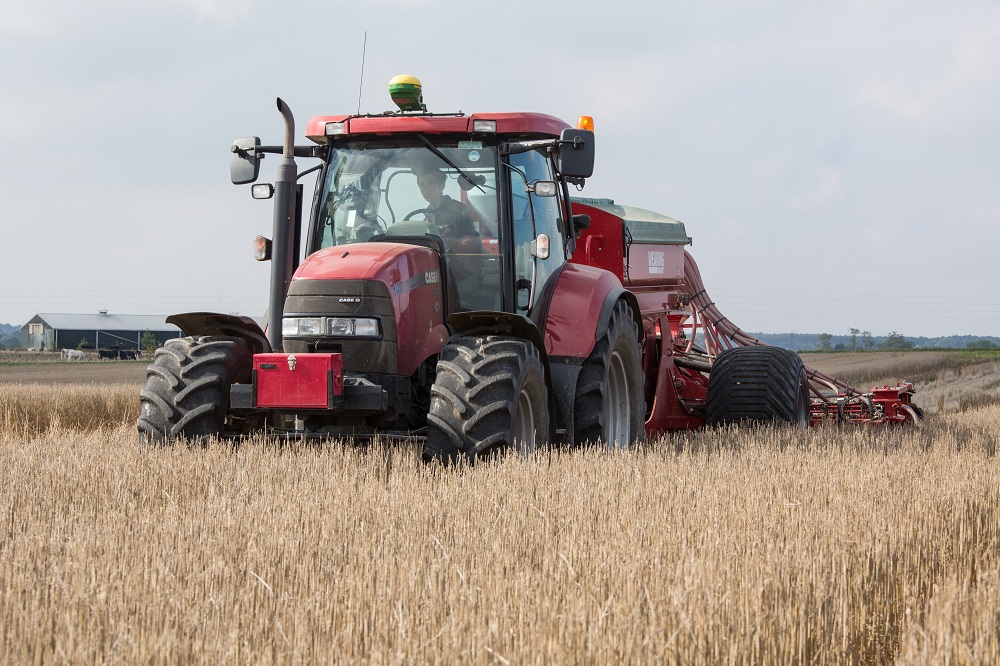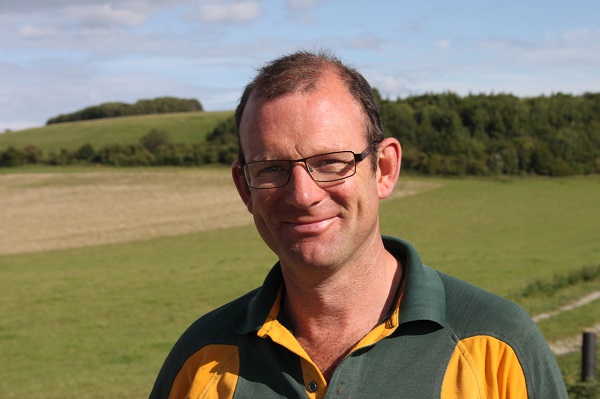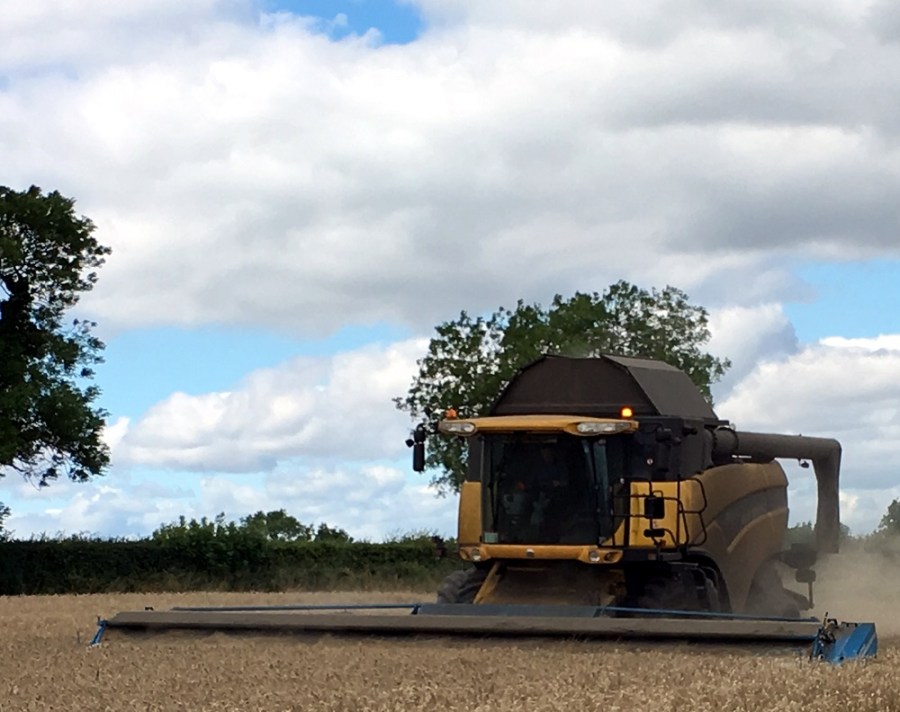
On the edge of Salisbury Plain, there’s a pioneering no-till approach that could have profound implications for how the practice is adopted on UK farms. CPM paid a visit.
The focus is on funding innovative technology.
By Martin Rickatson
There’s a history of agricultural innovation at the Hosier family’s farm near Marlborough, Wilts, where Arthur Hosier began farming almost a century ago. In the 1920s he made possible the inclusion of the rotational benefits of livestock grazing into the predominantly arable farming system practised on the chalky soils of Salisbury Plain, by designed a mobile milking bail that allowed dairy cattle to be kept on outlying land.
Today, his grandson Patric and great-grandson George farm the same land, part of a business now extending to 600ha, with 480ha in an arable rotation over a wide range of soils, plus 150 breeding ewes and a 150-strong suckler herd. The enterprise is currently beginning another plan to enrich its land, by blending rotational grazing and cover crop usage with the retention of standing crop residue by using a stripper header and establishing the next crop with a direct drill.

The main emphasis here are the environmental benefits, which complement the reduction in combine losses and rise in output, says George Hosier.
“We’ve recently been looking to go in a different direction, as I’m not convinced the way we’ve been headed over the past couple of decades is right,” explains George.
“Under our old system we were cultivating up to four times to process and incorporate residues, using a lot of steel, diesel and manpower and disturbing the soil a great deal, even with minimum tillage. What we’re now trying to do is disturb it as little as possible, to increase organic matter, build worm numbers, improve the structure and reduce the weed burden, particularly from blackgrass.”
The land spans clay over chalk, clay cap with flint and chalk with flint to easier loams and greensand. “I became intrigued by what soils could do for themselves after a few years ago seeing a farmer successfully drilling winter wheat into a four foot tall mustard cover crop. I was convinced our soils could benefit from the same process, feeding the soil biology with root exudates, putting carbon into the soil, restructuring via root networks and protecting the land from weathering,” he continues.
“That led firstly to our adoption of cover crops ahead of an extended rotation including spring cropping, to aid soil biology and structure ahead of the next crop. Straight behind the combine we began establishing cover mixes that include phacelia, vetch, turnips and radish, targeting those potential soil benefits. And we’re already starting to see soil improvements two years on.”
This has been aided by the inclusion of grass crops between combinable ones, not only to aid grassweed control but also to add some manuring benefits from grazing and contribute to the farm’s bottom line through the livestock they support. Over the next couple of years the Hosiers plan to increase suckler numbers, while the inclusion of grass is part of an expanded rotation which now includes winter wheat, winter and spring barley, oilseed rape, peas, beans and grass. Cover crops are grown ahead of all spring cropping, with the majority of the 200ha being grazed. The aim is to leave around 40% of top growth, thus starting the process of nutrient cycling, soil microbiology enhancement and recouping some of the cover crop growing costs.
But it’s the abandonment of minimum tillage in favour of no-till that has completed the system, reckons George. He uses the New Zealand-designed Cross Slot drill alongside a Shelbourne Reynolds stripper header for almost all combinable crops to allow the retention of full-height straw, the land remaining almost completely undisturbed between crops. These two machinery changes are reckoned to have helped counter common no-till problems, including straw breakdown, drill slot hairpinning and favourable slug environment problems associated with difficulties chopping and spreading straw successfully.
“Previously we’d used a Väderstad TopDown ahead of a Kuhn Megant tine drill, ploughing rotationally every few years to bury grassweed seed. Now the aim is to minimise soil disturbance as much as possible, so these were recently sold in favour of a 5m Cross Slot drill with the UK-type single-blade coulters,” says George.
“Of the no-till drills available, we chose the Cross-Slot because of its vertical inverted-T coulter design, which places the seed on a shelf of soil, meaning fewer issues with slot-closing, trash hairpinning or moisture retention. The drill also seemed strongly built, helping convince us it could comfortably handle working in the standing straw left by the stripper header.”
Since its arrival, a liquid fertiliser applicator has been added to the drill to allow placement close to the seed and aid germination, countering possible nitrogen lock-up through cover crop breakdown. This also compensates for the lack of nutrient mineralisation that would otherwise be caused by tillage, says George.
“During our first season with the drill, in 2014-15, we established half our crops under each system, and while some yielded more strongly than others, this was true under both systems. But we made significant savings in establishment costs.
“It was also notable right from that first season that ensuring no more than the absolute minimum of soil movement takes place significantly reduces weed-seed germination, and even the need for a pre-emergence herbicide – for winter wheat, no weed control has been required until March in recent seasons. That alone has cut £40/ha from our growing costs.”
But the key to taking the system a further step forward was to avoid disturbing the straw altogether by not taking it through the combine to then chop and create a slug-friendly environment. During their second year using the Cross Slot the Hosiers decided to trial a Shelbourne Reynolds stripper header, to see whether leaving straw standing and drilling straight into it would be feasible. Although manufactured in the UK, the stripper header has found much greater popularity in the US and Australia, where lower straw volumes make working into it a fairly insignificant challenge.
“Our heavier straw yields are a different story, but we wanted to see whether the Cross Slot could cope. Not only was this not an issue, but the stripper showed there were significant benefits from not taking high straw volumes into the combine.”
The Hosiers subsequently bought a 9.75m (32ft) Shelbourne Reynolds CVS32 for their New Holland CX8080 straw walker combine, retaining their conventional header for crops where straw retention is required for the livestock, and for OSR and beans.
“Otherwise we now use the stripper header for all combining,” says George. There are a number of additional benefits, such as lower combine losses and higher daily output. Forward speeds are up 20-30% and diesel use is lower.
But the main emphasis here are the environmental benefits. Minimal chopped straw also removes a significant source of slug habitat, notes George, with associated benefits from potentially reducing slug pellet use.
“Conversely, one of the challenges of reduced soil disturbance from the Cross Slot is less slug disturbance. Slug control is still a challenge, but rolling once in front of OSR establishment and twice behind is helping here, and the stripper header/direct-drill system will help build a favourable environment for slug predators.
“During the past two years we’ve used no insecticides nor seed dressings, mainly to try to help build beneficial insects both above and below ground. And during this time we’ve seen a reduction in slug pressure.
“At the same time, there’s been a significant increase in worm counts, rising from a farm average of 10-15 per spadeful of soil to an average now exceeding 30, while over the past three years soil organic matter has risen by 0.5-1.2% across the farm.”
Meanwhile, although in recent seasons neighbouring farms have needed to spray their OSR for flea beetle, the Hosiers haven’t found this necessary.
“There could be a number of reasons, including retention of stripped spring barley stubble and volunteers, the non-application of a pre-em herbicide – which I believe checks the early establishment – and having companion cropping of buckwheat and berseem clover to help a possible build-up of beneficial insect predators,” he says.
Is no-till farming part of Gove’s Green Brexit future?
Speaking at Jan’s Oxford Farming Conference, Michael Gove, Defra Secretary of State, suggested he recognised there’s no “inherent tension” between productive farming and care for the natural world.
He pointed towards a possible post-Brexit scenario where farming was supported with initiatives to minimise environmental impact and encourage environmental protection and development. So would there be support for investment in tools claimed to help protect the environment, such as no-till drills and stripper headers?
“I’ve seen for myself how many of our most productive and progressive farmers place thoughtful environmental practice and careful husbanding of resources at the heart of their businesses,” he said.
“Take the vital question of soil health. Min or no-till approaches, which require less expenditure on inputs and of course keep more carbon in the soil, are both economically more efficient and environmentally progressive.
“But under the CAP, farmers have been encouraged to focus on yield overall, rather than productivity specifically. This has led to decades of damage in the form of significant and destructive soil erosion – estimated in one study by Cranfield University to cost the economy around £1.2bn every year.
“We now have opportunity to reverse this unhappy trend. Sustainably managed land is far more productive than land that’s stressed and stripped of its nutrients.
“But moving to more sustainable and, ultimately, productive farming methods can involve transitional costs and pressures. So we plan to provide new support for those who choose to farm in the most sustainable fashion.”
And support for those who want to invest in technology that helps protect the land and environment around them, as well as aiding farm productivity, is already happening on UK farms. Growers considering equipment investments eligible for funding schemes are making a wise move, suggests William Dallimore, of Ngage Solutions, which provides funding advice and support services.
“The LEADER programme is designed to promote business growth and stimulate job creation, particularly amongst micro and small businesses, with enterprises able to apply for grants worth up to €200,000 – limits are set locally by each Local Action Group (LAG) – to help support their growth and sustainability,” he explains.
Under Priority 1 Agricultural Productivity, Defra has stipulated that it doesn’t want funding targeted at standard agricultural items for standard processes, but for innovative agricultural technologies that meet these aims.
“This still leaves many questions over what does and doesn’t qualify. The handbooks for these programmes have to be read carefully. However, I’ve worked with a number of farms which have qualified for funding via their investment in direct drills,” says William.
“The focus is on funding innovative technology, and the RPA does take an active interest in visiting farms and inspecting projects. As long as the equipment in question can be justified on the grounds of the influence it has on reducing impact on soils and harvest losses and use of inputs such as energy, water and fertiliser, then it should qualify under current programme rules.
“Projects must be contracted by March 2019, and the spending deadline is currently Dec 2019. There are indications from Defra that, after Brexit, there’ll be a scheme to replace it, but this remains to be seen.”




